The Real Door Zone Tragedy
The April 17 fatal dooring crash of Lenny Trinh in Burbank, CA, has ignited the blogosphere — and the blogosphere is getting it all wrong.
Before you read further, please stop.
Observe a moment of silence for Trinh’s memory, and for the agony of his family and loved ones. I feel a heavy sadness that this post even needs to be written. But we must address the sober task of learning from this tragedy.
Believe it or not, dooring never has to happen. The real tragedy is that door zone riding is so heavily promoted, even after decades of observing the carnage it causes. And the blogosphere is not addressing this tragedy.
Trinh was riding in a door zone bike lane. You can see it here:
Most dooring crashes aren’t fatal, but some are.
Cycling Savvy Instructor John Brooking has compiled a list of 36 fatalities, with names, dates and a narrative describing each crash. As happened last month with Lenny Trinh, most fatalities involve the “doored” bicyclist being run over by an overtaking motorist in the adjoining lane.
Why does this happen? The typical scenario is that the bicyclist almost avoids the open door, and her handlebar end catches on the door. The handlebars swing to the right, which dumps the bicyclist onto the pavement to her left. The nearby overtaking motorist can’t stop in time, and runs over the bicyclist.
An overtaking vehicle is not necessary for serious personal injury or death. Instead, the victim hits the ground hard enough to sustain a fatal injury. In at least one case that Brooking recorded, a helmet did not prevent a fatal head injury. This isn’t surprising. If you’ve ever tripped and fallen in the bathtub, you know you can fall fast and hit hard. Add in the bicyclist’s speed, and that’s a faster, harder hit.
Non-fatal door collisions are a dime a dozen.
From brain injury to broken collarbones, the injuries can be tragic. And there are so many of them! I recall an article about a door collision in Portland, Oregon, in which a sympathetic bystander said to the victim: “Is this your first time?”
Door collisions usually aren’t counted and totaled. Here’s why: For a bicyclist’s crash to make it into “the system” for purposes of counting and statistical analysis, it has to involve a serious collision with a moving motor vehicle. The swinging door doesn’t count as “moving.”
Because these collisions aren’t counted, some people prefer to believe they aren’t a frequent problem. To that I respond: “Count the personal injury lawyers whose practices are primarily focused on dooring crashes.”
One exception to “not counted” occurred in Chicago some years ago. The city was required to count door collisions, and it produced a map with a dot for every collision. The map has lots of dots:
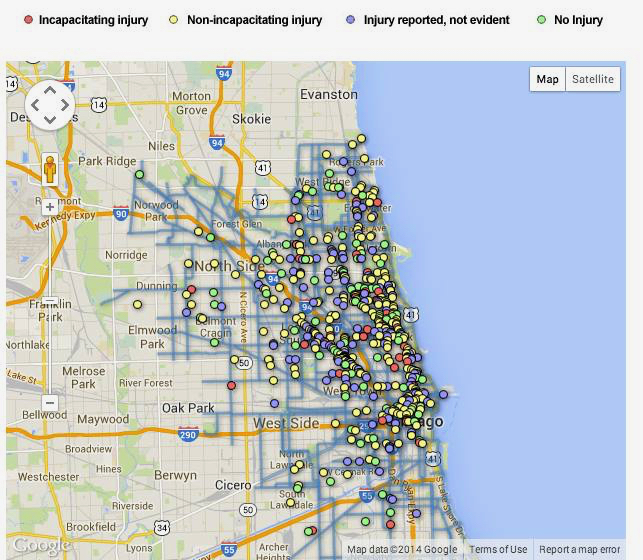
Dooring collisions have occurred for decades.
They cost millions. And when society believes cyclists should ride in the door zone, dooring collisions create the perception that bicycling has huge inherent dangers that can’t be avoided.
So we take a deep breath and ask:
What is it with dooring crashes?
Why do we have so many?
Why do we make so little headway in preventing them?
Why do engineers continue to stripe door zone bike lanes, when they know that crashes like Trinh’s are an inevitable consequence of door zone riding?
There’s only one way to avoid dooring crashes.
Here’s my premise: Safety results from safe behaviors. Traffic control devices should direct all road users to behave safely. A door zone bike lane fails this premise.
There is one, and only one, way for a bicyclist to absolutely avoid dooring crashes: Don’t ride in the door zone. So from my point of view, proponents of door zone bike lanes must dispute the premise that traffic control devices should direct all road users to behave safely.
Why?
Let’s start with the “respect” some people believe bicyclists “deserve” from the rest of society. This “respect” insists that motorists consider bicyclists they haven’t seen, don’t know exist, but may be sneaking up in their door zone. I’ve often heard people say that painting bike lanes green will increase respect and awareness — i.e., that motorists will see the green paint and be aware that a bicyclist might be there.
A bicyclist can prevent almost all traffic crashes by changing her own behavior.
Awareness didn’t work very well for Ayden Seguritan, a Yale-educated physician’s assistant. She was cycling in the door zone on Harvard Street in Cambridge, MA, and got doored. Then the motorist stepped out of the car. . . wearing her bicycle helmet. The motorist had just finished riding a bike herself.
How can you be more aware of bicycling than this motorist? Nope, “awareness” isn’t going to prevent these collisions.
Why do some bicycling advocates continue to beat the “awareness” drum — and actually ask for door-zone bike lanes — instead of going for the silver bullet of staying out of the door zone?
There are numerous reasons.
The biggest is an unwillingness to let go of an assumption: that edge riding is inevitable.
What’s edge riding? We think of bicyclist behavior as falling into three categories: Pedestrian behavior, edge behavior and driver behavior. A pedestrian-behaving cyclist rides on the sidewalk, and is very susceptible to many crash types. An edge rider, on the right edge of the road, is doing what most people think is safe, but which has its own long list of crash hazards.
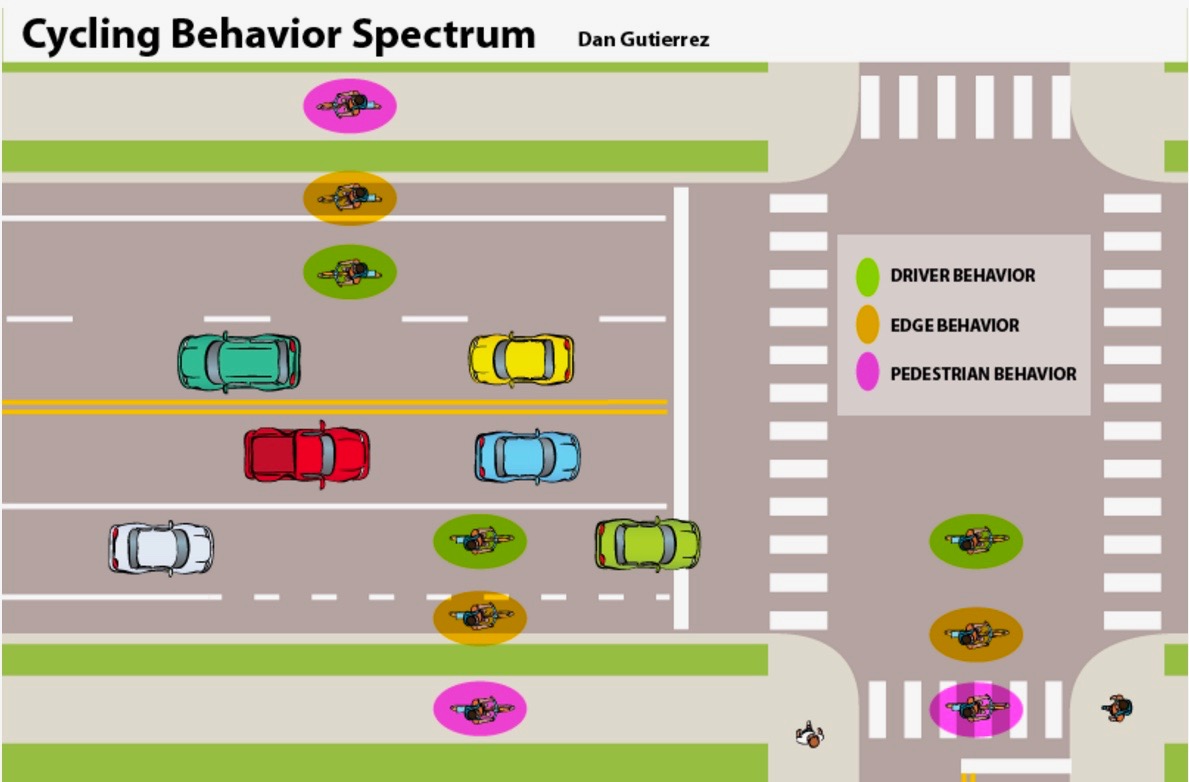
We all started cycling by being edge riders. And even though edge riding is at the root of most bicycle crashes, many can’t fathom the idea of not riding on the edge of the road.
This belief has many roots. One is that many people really still believe that overtaking motorists shouldn’t be inconvenienced in the slightest. (Changing lanes to pass! How difficult! What a first world problem!) It’s distressing how many bicyclists cling to this notion.
Another root, found among the jock set, is subliminal: edge riding is difficult and stressful. Jocks like to think that what they do is difficult, and that they are brave for doing it, and they are vaguely threatened by the notion of old grey-haired people blissfully riding in the heavy traffic they fear.
A third root is the concept that traffic control devices are promotional tools for bicyclists, not necessarily safety tools. Some bicyclists feel validated when they see a bike lane. It can be horrid — in the door zone, with a gutter seam and sewer grate, a pothole and mountain of broken glass. But by gum, it’s a bike lane, and that says the government loves bicyclists.
Andrew Boone, a Silicon Valley activist, described the love of bad bike lanes this way:
The whole San Francisco Bay Area features a very extensive network of bike lanes of all kinds — the good, bad, and the ugly. Door Zone Bike Lanes are probably the most common type and all the big local bicycle coalitions support them as ‘better than nothing.’ New ones are still being installed and very few are ever removed.
I have tried hard without success to convince the San Jose Department of Transportation to stop installing them but everyone in the department agrees they are ‘better than nothing’ so they keep installing them. This is pretty much true everywhere in the Bay Area — door zone bike lanes are viewed as an improvement even by most bicyclists and somehow most city staff members remain ignorant on the hazards of dooring.
Some engineers simply don’t understand the dangers, or think the dangers can be fixed with rabbit’s-foot countermeasures. That doesn’t work. Last month, the city of Key West, FL painted some door zone bike lanes green. A local cyclist sardonically announced that green was the new “hazard alert” color.
But this highlights another problem. You can’t make an unsafe behavior safe with paint. And it doesn’t work to change the color of the paint.
The city of Key West would do well to remember what happened when Portland, Oregon tried to make an unsafe bike lane safe. On May 16, 2012, shortly after the city put green paint in the bike lane on SW Madison Avenue, Kathryn Rickson was killed in that bike lane. Rickson’s death was the result of a bad bike lane design.
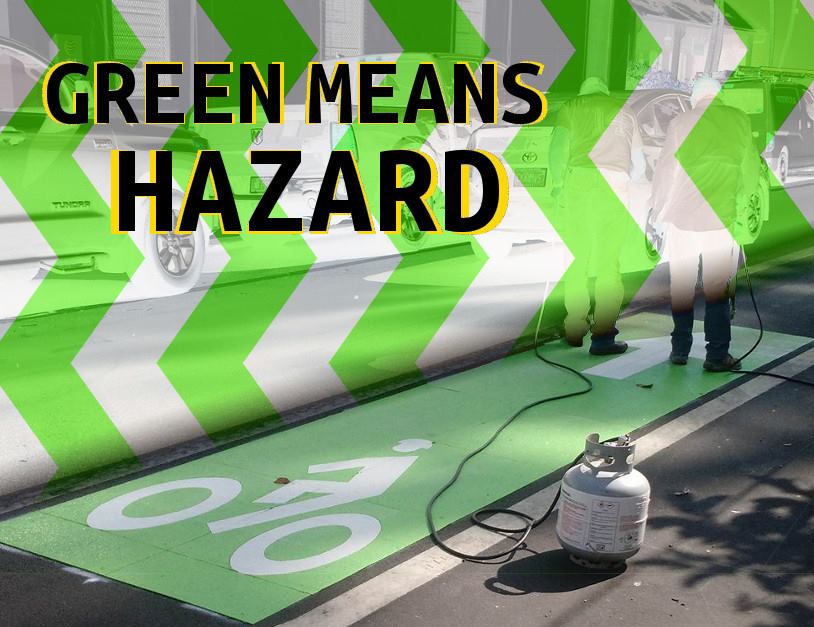
This door zone bike lane in Key West just got green paint
The CyclingSavvy approach doesn’t tell the cyclist to look for validation or personal safety in a politically motivated, poorly designed bike lane. Instead we tell you that your own behavior is what validates you and maximizes your safety.
A bicyclist can prevent almost all traffic crashes by changing her own behavior.
That very thought is alien to many. To some, it’s downright offensive.
You heard me right. Some people get offended when you try to tell bicyclists how to ride safer.
A surprising number of people prefer to view bicycle crashes as either (a) completely random, or (b) the fault of someone else. These beliefs fuel the society-wide opinion that bicycling has huge risks that can’t be managed. They’ve contributed to an overall decline nationwide in cycling.
Shouldn’t there be a law?
Well, there usually is. State laws typically find a motorist at fault for opening a car door and causing a crash. But the abysmal compliance with that law should convince you to neither rely on it nor tell other cyclists to rely on it.
Well, doesn’t the law at least give you the right of recovery after a crash? Big maybe. In one case, Washington DC Superior Court Judge Robert Skuker acknowledged that there was a law against opening one’s door in traffic, but also noted that the bicyclist had the right to use the right travel lane. The judge wrote:
[A] person exiting an automobile would not reasonably expect that a cyclist would be traveling at a rapid speed within a foot of her car. Accordingly, one could not conclude that a reasonable person should believe that cracking the car’s door no more than six inches would cause a cyclist to veer into a lane of moving traffic.
The judge ruled against the bicyclist (Wing v. Schmidt, September 1980).
Now it’s time to return to Mr. Trinh’s tragic case and the blogosphere. The countermeasure that bloggers have most often suggested is something called the Dutch Reach. This is a campaign to get motorists to reach across the steering wheel with their right hand to open the car door. The belief is that this will naturally cause motorists to look out for overtaking door zone bicyclists.
But the belief is bogus. There are numerous problems with this so-called solution that I’ll expand on another time. In the words of one knowledgable Southern California activist, Nevram Norman, “I’ve tried the ‘Dutch reach.’ It doesn’t force me to look backwards, it just crosses my arms.”
I eagerly await the day when it becomes common knowledge that bicyclists are better served by simply riding outside of the door zone.
A few months ago I led a CyclingSavvy group on a tour of Philadelphia. We were controlling the right travel lane on Spring Garden Street, staying outside of the door zone bike lane. An overtaking motorist — who was not inconvenienced, even for a second, in changing lanes to pass — told us to get in the bike lane. And just like that, a Toyota Prius door flung open in the bike lane.
We weren’t in danger. We didn’t care. We were riding safely.
Friends don’t let friends ride in — or promote — door zone bike lanes.
>>>>>>>> This article has been updated with a correction. An earlier version said the city of Key West was using green paint to highlight the known hazard of a door zone bike lane. That is incorrect. The city does not believe that design is a hazard. <<<<<<<<<<<

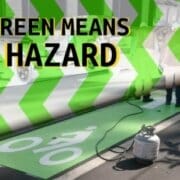
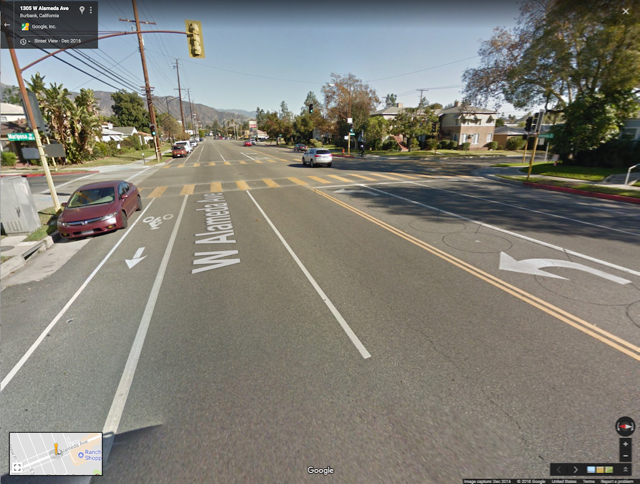
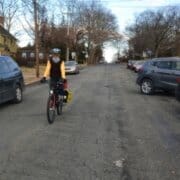
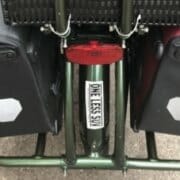
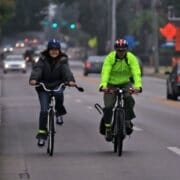

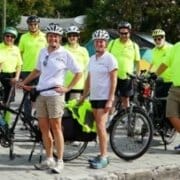



Excellent article. Too many quotes to list.
Great article, John! Thank you!!
About my spreadsheet of dooring fatalities: It’s not an attempt to be complete or official. After the initial compilation, I’ve mainly just added ones I happen to hear about over the years. If anyone knows of any I’m missing, please contact me and I will add them.
Thanks for this article on an important cycling topic.
My recollection is that several years ago the entire state of Illinois started requiring all municipalities to start recording door-zone bike crashes and that should be continuing today.
So I wonder if more current data is available from Chicago and other cities in Illinois.
This report includes the Chicago doorings in 2014 and 2015.
https://www.dnainfo.com/chicago/20170426/portage-park/bicycle-dooring-accidents
With over 50 years of cycling experience, I have seen a change in dooring. In the past, a car would pass you, park, and you expected the door to quickly open. Even if you were in the door zone, you had some warning. Now a car can be parked, long before it came into the cyclist’s view, with driver engaged with phone. Then BINGO, out flies the door.
A few summers ago, I was passing a parked car when the driver, who had been apparently just sitting there, lazily extended his arm out the window with a lit cigarette at the end of it. I’m glad I was outside the door zone!
Then last summer, a wrong-way cyclist came out from behind the front of a parked car as I was passing it. The car was hiding both of us from the other. Fortunately, I was far enough into the lane to not him him head on, but I did swear at him as we passed.
Great observation, Linda! Thank you!
That describes my own behavior. Quite often, I have a message to answer or a mapping program to close before I open the door.
That reminds me, Linda, on the way to your house the other day in Hillcrest while looking at something on the left side of the street I suddenly heard a creaking sound. I turned towards the sound coming from my right and sure enough, a door opening. Of course I didn’t even have to flinch because I was well out of the door zone, by habit.
By, yeah, I too have noticed people hanging in their cars much more than they did before. But I’ve noticed this more in parking lots when driving and looking for a spot. Back in the day when you saw someone getting in their car, you knew you were good; that spot is about to be yours! Nowadays they might sit for God knows how long before leaving… But of course this applies to people parking at the curb too, like you said. After parking, they check Facebook for a few minutes before suddenly swinging the door open. I do wonder if this is increasing the incidence of doorings.
Brilliantly done article on the “door prize no one wants” (borrowed from a big anti-dooring campaign done in Toronto 10 yrs. or so ago). John, I’m going to add the fatal crashes relt’d to dooring that you’ve documented to the Ride of Silence Memorial database after this year’s Ride of Silence, which is next Wed., May 16th by the way. Please join your local event and ride to remember our fallen brothers and sisters of the wheel.
Note to those of you who have a problem with the RoS happening during Natl. Bike Month (basically MOST of the large bike advocacy groups): many events end with an after-party to celebrate and encourage those working to strengthen the safety of bicyclists’ on our roads, so they don’t all end up being depressing events.
While John S. has written much that is interesting, he has ignored, perhaps deliberately, the most important factor in the cycling issue. That is, American society’s program for cycling is set up to keep cyclists out of the way of same-direction motor traffic. One may argue about the motive, but the fact exists. It exists through the belief that the greatest danger to cyclists, by far, is same-direction motor traffic. As long as the program is driven by these superstitions, responsible engineers will squeeze in DZBLs because they accept the small danger of dooring compared to the much, much greater danger of getting in the way of same-direction motor traffic. That is the
action of the cyclist-inferiority phobia. It is a phobia because it is contrary to fact and controls political action; only 5% of car-bike collisions are caused by same-direction motor traffic, while 95% are caused by crossing and turning movements by either or both parties.
Lawful, competent cyclists must reject the phobia and replace the government’s program for bicycle transportation by generating support for rules of the road cycling and support also for fighting off government’s efforts to prohibit rules of the road cycling.
John F,
American society’s program for cyclists reflects the widespread belief that from-behind is the greatest threat to cyclist safety.
Focusing on the hazards of dooring is a gateway to change that thinking among the masses, including most other cyclists, who are totally unaware of the safety and traffic-comfort benefits of using the full lane. Jumping immediately and directly into the underlying causes can be off-putting and ineffective. I think John S’s approach is probably quite effective. We’ll see.
One step at a time…
Serge
Hello,
Do you have counter-direction lanes in the US ? You could find these lanes in France in low speed zones that are called “meeting zones”. These bicycle lanes are in the dooring zone of the cars in front of you. If you are lucky, bikes are painted in white on the ground and if you are luckier, there are white signs to let to know to the car drivers they can’t use the way. There are more and more lanes like this in Paris. What do you think about this ?
That’s the one I use every evening : https://www.google.fr/maps/place/Rue+du+Cherche-Midi,+Paris/@48.8481496,2.3239021,3a,75y,37.15h,88.43t/data=!3m8!1e1!3m6!1sk1idxDdc2S2ku2d4o87y_w!2e0!3e11!6s%2F%2Fgeo0.ggpht.com%2Fmaps%2Fphotothumb%2Ffd%2Fv1%3Fbpb%3DChEKD21hcHNfc3YudGFjdGlsZRIgChIJczM38dJx5kcR7342VBVGEPcqCg0AAAAAFQAAAAAaBQhkEMsB%26gl%3DFR!7i13312!8i6656!4m5!3m4!1s0x47e671d2f1373373:0xf710461554367eef!8m2!3d48.8480932!4d2.3237847
Jean-François, these types of facilities don’t exist in the US. The closest you`ll see may be something like this
https://youtu.be/cYbzFizm9Gk
Hello Jean-François,
What do I think about the street view you shared? I’m always worried when the road design creates conflicts. But I haven’t been to Paris in 33 years, and I’d want to see more and know more before commenting further.
The video that Frank posted is a nightmare because of its complexity. Who is supposed to look where and do what? The nature of traffic is that you have to look and make decisions quickly. Every time you make a decision more complex, or add a place to look, you introduce another possible failure mode. I bet my friend John S. Allen got a splitting headache making that video!
Frank is incorrect. Contraflow bicycle facilities do exist in the USA, and other countries as well. See my article here: http://bikexprt.com/bikepol/facil/lanes/contraflow.htm . The facilities can be well-designed and safe, or hazardous. I have never before seen one as absurd as what Jean-François has shown us, though. On a narrow, small street like this, German practice, as described in a paper linked form my article, is for bicyclists to ride in the middle of the street, and for cyclists and oncoming motorists to negotiate when they meet. This french ezample shows an arrow in the street where bicyclists couldn’t ride without their handlebars striking parked vehicles.. Thank you Jean-François!
John,
Did you see the Google Streetview in Jean-François‘s post? I was referring to the configuration shown in that.
Yes, I saw that. I describe extreme door-zone right-way bike lanes as being in the taillight zone,and that contraflow lane is in the headlight zone.
Sad news: Yet another fatal collision with an open car door.
You can read about it at the link below.
Our friend John Brooking has updated his on-line spreadsheet listing the fatalities.
This is what happens when you promote door zone bike lanes, and edge riding with or without a bike lane.
https://www.nbcnewyork.com/news/local/Queens-Bicyclist-Killed-Parked-Car-Door-Opens-484009421.html
The presence of a bike lane creates a mindset in drivers that the cyclist MUST use it. The resulting honks and comments towards riders outside of the DZBL can be scary, unsafe, confrontational and distracting.
I suggest an update on your update:
This article has been updated with a correction. An earlier version said the city of Key West was using green paint to highlight the known hazard of a door zone bike lane. That is incorrect. The city does not ACKNOWLEDGE that design is a hazard
Dear John Schubert,
You allege that the Dutch Reach is “bogus” & does not provide safety benefit to cyclists. I of course beg to differ and invite you to visit the website http://www.dutchreach.org before you prepare a column devoted to debunking this 50 year old Dutch countermeasure & the campaigns underway to promote driver & passenger habit change.
May I refer you to two helpful links as you prepare your critique?
First, take a close look at this bike cam video:
“Holland stílusú ajtónyitás mentett meg – Dutch reach saved me”
https://www.youtube.com/watch?time_continue=21&v=c7jzz27vKeY
The above Hungarian YouTube of a high risk dooring AVOIDED by use of the ‘arms crossed’ Dutch Reach technique. It shows a cyclist – yes riding in the doorzone which I agree is not wise – but who becomes boxed by an overtaking auto as he passes a parked car. That car’s driver – as you can see at stop frame 23sec. obtained a direct view back via propped door using the Reach as you can see through his window. The driver thus knew of the approaching cyclist & delayed opening until the cyclist was safely past.
I provide a still image of the moment of safe passing & comment on the protective use of the DR at the the very bottom of this Dutch Reach Instructions Guide webpage:
https://www.dutchreach.org/dutch-reach-instructions/
Second, I strongly suggest that your study my rebuttal to Cycling Savvy Instructor John S. Allen’s blog post in which he sought to dismiss the Dutch Reach
http://john-s-allen.com/blog/?p=7076
Mr. Allen eventually steps back his critique & rhetoric in response to my point by point rebuttals which appear in the comment section beneath his post. So please read the comments in full – and do study the DR website – as many of the criticisms I expect you may raise have already been answered, or in practice been refuted by progress during last 21 months of the DR grassroots campaign.
I look forward to your promised column and hope it will fact and not rhetoric based.
Yours truly,
Michael Charney
Dutch Reach Project
http://www.dutchreach.org
@dutchreach on Twitter
The Dutch “reach” seems to be misnamed. What the video shows is the Dutch “door crack”.
The trick is to open the door slowly.
The door crack is not free of hazards either. See the original article’s discussion of the Wing v. Schmidt court case, in which the door crack caused the cyclist to startle and lose control.
Ah, so the trick is to crack open the door *before* the cyclist arrives (as the video shows). Putting it all together:
1. Check the mirror
2. Crack open the door
3. Turn and look back
The Dutch Reach is the third step.
Yes slow exiting with vigilance throughout is key.
BTW, see Officials’ Dutch Reach Instruction Guide for a detailed examination & explanation of the multiple linked steps & advantages of the DR exiting process:
https://www.dutchreach.org/dutch-reach-instructions-2/
The 2015 Dutch driving instruction video also found there, with translation, shows much of the same. But I counsel slower partial opening & exiting.
John,
Yes, opening a car door is never always free of hazards, nor is justice inevitably just – especially when bicyclists are victims.
And arguing opposing anecdotes can be intereresting of course.
So here’s a counter-anecdote of a dooring by a mirror-reliant police officer – with comparably unjust justice:
Toronto cop parked in bike lane ‘clearly to blame’ for dooring cyclist, but SIU says charges aren’t warranted
https://www.thestar.com/news/gta/2018/11/13/toronto-cop-parked-in-bike-lane-clearly-to-blame-for-dooring-cyclist-but-siu-says-charges-arent-warranted.html
One of the cyclists asked if the officer checked his mirror.
“I did,” he said. “As soon as he (motioning to the third cyclist to pass) passed I opened the door and that was it.”
The officer said he “thought (the struck cyclist) was slowing down so I opened it and he was going to go around me but he didn’t, he went into me.”
As I understand it (partially) the officer relied on the mirror, cracked the door while waiting, but did not look back through the partly opened door but relied on mirror and inference before fully opening and dooring the next cyclist.
C’est la morte!
Lastly, one can also cite dead cyclists “startled” by full wide door ambushes causing swerve crashes. At least with a nudged open door there might be 1) more room to avoid, & 2) advanced warning & time to brake brake or maneuver more safely – if a cyclist is filtering or in the DZBL.
So yes, avoiding the edge IS important. Also, reliance on wing-mirrors can be dangerously unreliable due to maladjustment, head-motion, door-motion if mirror affixed to door, blind-spots, glare, dirt, darkness, rain, ice etc.
DR provides wing mirror PLUS curbs fling, shoulder check etc. See Instruction Guide for detailed explanation: https://www.dutchreach.org/dutch-reach-instructions-2/
Yes, the far hand Reach initiates the sequence which leads to this peek back: Opening with the far hand on the latch leads to swivel, wing mirror view, out to side & easier shoulder check. Then as one opens – or as you say, ‘cracks the door — slightly one gain a direct view back through the partially opened door before fully opening to exit. Reaching across curbs door fling as well.
As for naming, ‘door crack’ is a late aspect of the maneuver. Dutch Reach conveys provenance, motion & consonance. Its outre connotation has been a social marketing bonus!
BTW, see Officials’ Dutch Reach Instruction Guide for a detailed examination & explanation of the multiple linked steps & advantages of the DR exiting process:
https://www.dutchreach.org/dutch-reach-instructions-2/
The 2015 Dutch driving instruction video also found there, with translation, shows much of the same. But I counsel slower partial opening & exiting.
Michael, you’re not making your sale here.
When you swivel your torso and arm as you describe, your head is no longer positioned to look out the mirror. So now you have to take yet another step and swivel your head to your right to look at the rear view mirror that was already in plain view _before_ you made the torso twist maneuver. Speaking as a guy of many years with a stiff neck, I think this is important. Plus, this is an additional step which is not conveyed in the compressed version of explaining the Dutch reach, “It makes you turn and look behind.” The compresed version is what will get told. Most people won’t give this the attention that you give it.
And once you’ve “cracked” your door, you have given overtaking door zone cyclists reason to swerve, as explained in my discussion of the Wing v Schmidt court case. For that reason, I don’t particularly care whether a parked motorist can see overtaking door zone cyclists through the door crack, because I don’t advocate that motorists do that. But I suspect the door would have to be open about six inches for this to be effective. (Perhaps after the Polar Vortex has passed, I’ll do another experiment and photo shoot, but I consider it to be hazardous advice to tell motorists to open the door any distance until they have seen that the area is clear. Which is best done with the rear view mirror.)
We haven’t discussed the concept of perishable information. In any traffic situation, information that it’s safe to do something — pull out of a side road, open your car door, etc — may only be valid for about a second. With bicycle traffic moving at about 20 feet per second (less than 15 mph), a bicyclist who was invisible can very quickly become in your zone in the time it takes to perform a multi-step process. So many bicyclists will ride in empty parking spaces, and then swerve out into the door zone just before they reach a parked car, that this is a real problem. Hence, I say, keep it simple and quick.
” The compresed version is what will get told. Most people won’t give this the attention that you give it.”
According to a British survey – I assume self-repporting and thus an underestimate – about 1/3 of UK drivers don’t bother to check at all when exiting their vehicles.
For this most negligent set of current motorists being urged to use the DR & learn the concept of “dooring” for perhaps the first time – is I believe a good thing – for VRUs & themselves & their doors, as well as society.
As described in the Instructors’ Guide, ;the DR is a linked process which leads to a sequence which have multiple advantages. Strange as it may seem, AAA, NSC, RoSPA, MA & IL DMVs, LAB, & Dutch road safety experts think this maneuver provides a greater margin of safety than the near hand fling. And works for rear seated passengers who lack mirrors entirely, and front driver side passengers who don’t have interior rear view mirrors. Go figure.
Cyclists need to avoid the doorzone. Drivers need to act in a habitually safer manner.
The near hand method has been the “standard” – itself never properly tested against the far hand – in NL nor anywhere else.
But in CA, US, UK, AU we both know the near hand push method – with or w/o side mirror use – is the “method” of habit. And apparently fails to prevent epidemic doorings.
So do you therefore prefer: Open with near hand or Open with far hand as your simplest message to drivers & passengers? We both would like to improve driver/passenger exiting behavior & proper use of mirrors etc.
I’m of the opinion that the near hand habit is inherently defective as, among other things, it is prone to immediate thrust wide opening. Switching to the near hand curbs that perforce. This alone to me is a most convincing reason to go Dutch.
Please continue to debate.
Oops! Switching to the FAR hand corrects that perforce!!
FYI as cited above – 35% likely an under-report as presumably it was self-reported.
35% of drivers don’t look before opening their car door
Survey highlights drivers’ ignorance and bad habits
https://www.bikeradar.com/us/commuting/news/article/opening-car-door-cyclists-50020/
Cyclists riding well away from parked cars never have to worry about being doored.
I did some testing of the “Dutch Reach” a couple years ago, using three different motor vehicles, and found that, in all cases:
A) I could reach the seat belt buckle without turning my head from the straight-ahead position. The seat belt buckle is routinely eighteen inches or more abaft the door latch handle. My takeaway here is that many motorists are going to sometimes be a bit lazy, and won’t turn all the way around just because they are using their right hand to unlatch the door. I can avoid being doored by such motorists with 100% effectiveness by riding well to the left of the door zone.
B) The structures that support the roof of the car obstruct my view in the relevant direction, even if I DO turn my head. My mirror is adjusted to see the relevant directional view, and I check it to be sure that there is no motor vehicle traffic approaching before I open my door, since the penalty to me of the resultant crash would be loss of my vehicle door. As a cyclist, I can avoid the problem entirely by riding well outside the door zone.
Furthermore:
No matter how much time and effort gets devoted to promulgation of the practice, there will remain a sizeable chunk of the motoring public that will not be aware of the Dutch Reach, and those people will still open their car doors using their left hand without turning to look for cyclists. I can avoid the dooring crashes that would result from this with 100% effectiveness by riding well out of the door zone (and there seems to be a pattern developing, here–as a cycling instructor, guess what I’m going to teach?).
So, in summation, teaching the Dutch Reach is, at least in my mind, a waste of time and resources that could be better put to use teaching cyclists to not ride in the door zone in the first place (and teaching motorists to recognize that cyclists have very good reasons for NOT riding in the door zone). This means that the Dutch Reach is not only not beneficial, it is not even harmless; it normalizes having cyclists ride in one of the most dangerous same-direction lines of travel possible.
Yes, and bicyclists can be lazy – and fearful too – and many will inevitably spend time in the doorzone. If what works for you works, do it. Other drivers and passengers and road safety experts disagree with your assessment. So be it. As for normalizing edge riding. Its already normal. Its up to you & CS advocates to do a better job of educating & persuading cyclists to do otherwise. Meanwhile visit http://www.dutchreach.org, review the Current News & Archives, see how much traction ordinary drivers & passengers & media are responding to it, as well as bike organizations & dooring victims, and open you mind to the possibility that we are all pulling in the same direction – safer road sharing for all. And that the DR is not making things worse – rather it is heightening attention to dooring & cyclists, and in fact swaps out one thoughtless flawed habit with a thoughtless safer habit.
Michael Charney, in most of you replies, you ask us to visit Dutchreach,org. So I did that just that although I’ve visited several times before. The website is highly disorganized, cluttered, and a headache to use but that’s a discussion for another time.
Thanks to today’s visit to Dutchreach.org, I noticed AAA Southern California recently jumped on the Dutch Reach bandwagon. This is the only effort to teach the Dutch Reach that I know of in my region.
It says:
>>Bicyclists and Car Door Safety
Use your right hand to open the driver’s side door, which will force turning your body. This will help you notice passing bicycles, motorcycles, or cars on the traffic side of the vehicle.<<
Missing from AAA SoCal's PSA, or at least what's provided on Dutchreach.org, is the part of the detailed (and cluttered) instructions (https://www.dutchreach.org/dutch-reach-instructions-2/) asking motorists to check their mirrors. In your detailed instructions, you mentioned in step 2 ("Check both outside and inside rear-view mirrors for vehicles & cyclists in back and in adjacent bike or travel lane") and 4 (Mid-swivel, (again) Check side/wing mirror. [Note: Near hand habit does not induce side-mirror use.]) to use the mirror.
In fact it appears many other instructions or PSAs, at least in the English-language, as well as your simplified instructions (on the front page of DutchReach.org) leave out this important step of using the mirrors.
Now I've practiced the Dutch Reach myself, or at least tried to, using several different vehicles – a Subaru Outback, a Ram 2500, a Jeep Cherokee, a Jeep Wrangler, a Ford F-150, a Nissan Frontier, a Mazda 3, a Toyota Corolla, and a Toyota Prius. When I swivel, which is something I'm not "forced" to do, I have to remember to do it (instead of simply crossing my arms) in any of these vehicles, my field of vision is mostly the B pillar of the vehicle and a bicyclist/scooter riders/etc could easily be hidden in that area. In order to actually see somebody in the door zone, I have to use my rear view mirror, followed by using the wing mirror. Unlike many motorists, I also have my wing mirrors adjusted so that none of my vehicle's body is in the field of view and the wing mirrors do not overlap with the scene in the rearview mirror. In other words blind spots essentially do not exist. It's using the mirrors is what enables me to see who is coming, not the twisting. It's precisely using the mirrors, properly adjusted, that are how at least a motorist can determine whether it's safe to open the door. This of course assumes that the motorists remembers to bother to check in the first place, Dutch Reach or not.
As I wrote this reply, I observed out my window a motorist parallel park in front of my house, he was stopped for about five minutes before he exited the vehicle. In one of his hands was a smartphone. One can assume he was using his phone those five minutes he remained in the car after parking and would likely not even remember to use mirrors or the Dutch Reach.
Hopefully you're aware of the following:
Motorists typically don't drive in the door zone, and if they do, at least they have a cage to protect them. Motorcyclists are instructed in safety courses and when they obtain their license to not ride in door zones.
But cyclists for whatever reason are essentially told, by society (FTR/MBL), unethical engineers (hazardous door zone bike lanes), "advocates," and others to ride in this area. In addition to being hit by an opening car door, or startling to avoid one, cyclists are also invisible and irrelevant to other road users. This places them at risk for right hooks, left crosses, drive outs, pull outs, walkouts, and a very lateral limited operating space. The Dutch Reach makes no attempt to change this.
Frank, I appreciate your concerns.
1. re: Besides AAA Southern California…City of San Francisco’s SFMTA & Uber SF “jumped” on the far hand reach (before I did) with two videos both advised by SF Bike Coalition, viz:
Uber’s Sharing the Road with Bicycles (2016) at 1:00 min: https://www.youtube.com/watch?v=DlQXb5GbfCo
&
Large Urban Vehicle Driver Safety (2015) SFMTA at 14:30 m/s: https://www.dutchreach.org/uber-ride-share-bike-safety-videos/
2. re: Failures to include mirror check or other aspects of DR sequence.
Clearly a significant issue, not just for DR but most all behavior change campaigns as KISS – Keep It Simple Stupid! is a guidng principle for reaching John Q. Public. On my Home page a short headline version (<>) is followed immediately below on left with a somewhat longer version which includes mirror reference. The “cluttered” Officials’ DR Instruction Guide is, surprisingly, for experts! Driving instructors, officials, advocates, folks who may want or need to know specifics so they can explain or teach or present the subject more knowledgeably.
Obviously I cannot police or standardize all iterations of the DR meme & its presentations in text, graphics, video, TV, blogs, etc etc. Over time hopefully the good & useful versions will prevail! Fortunately to date, the most viewed video (over 3M) does note mirror check – though it fails to note “fling curbing” which I personally consider a very protective feature.
re: The DR makes no attempt to challenge societal, engineers, gov’t’s pressures for cyclists to edge ride.
Guilty as charged. DR’s job is to urge use among drivers & passengers of the simple, free, safer thoughtless far hand habit and to supplant the inherently flawed & often heedlessly executed near hand push or fling.
I fail to see how DR advocacy undermines efforts to normalize taking the lane which is a highly commendable goal.
For a splendidly disorganized, cluttered, headache-inducing treatise on “Dooring Self Defense for Cyclists” in which I endorse taking the lane as a generally appropriate practice, see: https://www.dutchreach.org/dooring-defense-for-cyclists2-2-2-2-2/
Thank you for your helpful skepticism!
Michael, there is exactly nothing in your response to me that adequately advocates for teaching the Dutch Reach over teaching cyclists to not ride in the door zone in the first place.
Yes, it is up to CS advocates (and, frankly, a fair number of LCIs who taught the same thing–that door-zone riding is extremely hazardous–before CS came to be) and others to teach against door zone cycling. That’s part of why this blog post exists.
I don’t know of any road safety “expert” that advocates for looking at one’s b-pillar (which is precisely what the Dutch Reach does) to see upcoming road users.
You mention passengers. I went out and tested with my current car–a Pontiac Vibe–to see whether your beloved Dutch Reach helped, and all I could see was the C-pillar. If I open the door enough to see in the necessary direction, it is already in the path of a cyclist in the door zone. That doesn’t endear me to your suggestion at all.
I continue to say that advocating for the Dutch Reach is a waste of valuable resources, one of which is the attention span of John Q. Public.
And your web site is so discombobulated that even in my more patient moments, I wouldn’t be able to glean any sound information about the Dutch Reach that didn’t fit into a fifty-word quip I’ve already seen a dozen places online (and can refute in far fewer words than I’ve already wasted on this post).
Tom,
Thank you for your observations.
1) re: Michael, there is exactly nothing in your response to me that adequately advocates for teaching the Dutch Reach over teaching cyclists to not ride in the door zone in the first place.
Reply: I advocate teaching DR to drivers & passengers, & for cyclists to urge them to do so as well. I also support taking the lane by cyclists as a generally safer practice.
2. re: I don’t know of any road safety “expert” that advocates for looking at one’s b-pillar (which is precisely what the Dutch Reach does) to see upcoming road users.
Reply: May I introduce you to Prof Fred Wegman, formerly of SWOV NL – the Dutch Road Safety Institute? https://www.nytimes.com/2018/10/05/smarter-living/the-dutch-reach-save-bicyclists-lives-bicycle-safety-drivers.html
Or Prof. Ruth Oldenziel of Eindhoven U. NL, editor of Cycling Cities – 100 Years of European Experience http://www.cyclingcities.info/
Or Dr. James S. Solomon of National Safety Council’s Defensive Driving curriculum development office?
But if you can’t manage to peer back out through a partially opened door, then stick to you wing mirror by all means despite its having its own limitations.
3. re: “I continue to say that advocating for the Dutch Reach is a waste of valuable resources, one of which is the attention span of John Q. Public.”
You are welcome to your opinion as of course I am to mine. But as 1/3rd of all drivers per the British survey don’t bother to check for oncoming before exiting, I will argue that the “valuable resources” “wasted” to date by the Dutch Reach Project in influencing UK, So. Aus., Berlin de, MA & IL has been well spent.
For in each of the above states it has been the subject of considerable attention getting interest and brought awareness to “dooring”. And has also fueled debate & policy changes to better address the dooring scouge. That the DR has now reached at least 38 countries & been translated into ~27 languages demonstrates enormous “return on investment” given that the Dutch Reach Project is all volunteer & out of pocket less than $1000 since June 2016. Thus to complain of “wasted valuable resources” seems odd to say the least.
Bottom line, there is no shortage of available resources left for Taking the Lane if you know how to inspire it.
4: re: Website discombobulation etc.
Happy to say Tom I’m in total agreement with you! It’s a mess! But it has a certain charm…and proven efficacy.
Hi Michael,
We thank you for your work regarding bicyclists’ safety.
However, I think we are going to have to agree to disagree about the Dutch Reach.
Responding very briefly to your thorough letter:
— I spoke with John Allen, and he told me that his communication with you does not negate the big picture: he continues to believe the Dutch Reach is ineffective.
— John Allen added: “Dutch Drivers obviously are not turning their heads and looking back for overtaking cyclists before opening the door, because that doesn’t work in the Netherlands either. Looking in the rear-view mirror works better to avoid dooring and merge-outs but it is still not reliable: a cyclist may come from directly behind a vehicle and into the path of an opening door.”
— I have photographs showing how the Dutch Reach puts my head in a position where I cannot see an approaching bicyclist in the door zone. (The photos were taken with a 10 mm lens on a DSLR camera, so there isn’t much question about field of view.) Others have taken similar photos. I don’t have a way to post them here, unfortunately.
— We view our communication with bicyclists as time limited. We want to tell bicyclists to stay the hell out of the door zone, in a direct way that gets them to do so. That goal is subverted by a lengthy discussion of a disputed measure said to make door zone riding less hazardous.
— Colliding with an opening car door is far from the only problem with edge riding. An edge rider is more likely to collide with motorist emerging from driveways and intersecting streets, to be screened from view by overtaking motor vehicles so that s/he is susceptible to a collision with an oncoming motorist turning left across his path, and more likely to experience a deadly right hook collision at intersections. This is an incomplete list, but it underscores the core point: avoiding the door zone isn’t just about dooring. It’s about all the hazards on the road edge.
— When we talk about the Dutch, we sometimes forget how very skilled they are. I know, I know, they don’t wear spandex or ride 15-pound bikes. But they are very skilled in the ways of their traffic environment, and part of that skill involves knowing how to evade the shortcomings of their laws and traffic control devices. That skill is a vital part of their relative safety.
Again, my thanks.
John Schubert
Hi John,—
re: “John Allen added: “Dutch Drivers obviously are not turning their heads and looking back for overtaking cyclists before opening the door, because that doesn’t work in the Netherlands either.”
Thank you for sharing JSA’s assurance. CS might wish to share it with Henk van der Zwan as Henk has apparently spent too much time away in Ottawa:
Ambassador demonstrates the ‘Dutch reach’
https://www.cbc.ca/news/canada/ottawa/dutch-reach-ambassador-ottawa-1.5110309
“Mr. Allen eventually steps back his critique & rhetoric in response to my point by point rebuttals which appear in the comment section beneath his post.”
Don’t you dare put words in my mouth, sir.
FYI: JSA’s Blog/Comment on Dutch Reach:
jsallen | April 26, 2017 at 3:23 pm | Reply
“If drivers learn to check for overtaking bicyclists, well, good…”
I certainly apologize if I misrepresent John’s current views on the far hand maneuver and of my ongoing advocacy for it.
Actually JSA’s views & critique of the DR has evolved from broad rhetorical claims to arguing that the DR does not work as claimed.
The later is to my ears a stepping back into attempts at evidence based argument which we all should welcome. However not all ‘evidence’ is equal. For example argument from anecdote or personal testimony has only limited truth value as such normally have many confounding circumstances and inferences associated.
But note for example the quotes below from JSA’s initial DR-disapproving Blog Post of Feb 3, 2017. There he makes a series of claims which I take as rhetorical overstatement and ‘putting words’ onto whom? me?, eg:
“Promoting the Dutch Reach as if it would make door-zone bicycling safe promotes the false belief that most car-bike crashes on urban streets are overtaking crashes.”
“Bicyclists who rely on the Dutch Reach are defining themselves as helpless victims,..”
“Promoting the Dutch Reach perpetuates the idea that bicyclists are second-class citizens,..”
“…you are promoting a single practice…whose promotion unfortunately reinforces common misconceptions and distracts from comprehensive solutions.”
That JSA may have moved on to engineer-minded examination of this old Dutch maneuver is to my mind progress away from rhetoric toward atltempts at constructive analysis.
While the jury at CS may have already reached an unfavorable verdict, a larger outside jury of road safety experts seems intrigued and leaning toward the far-hand.
Yet another door fatality. This one was in San Francisco.
http://www.sfexaminer.com/cyclist-struck-killed-south-market-neighborhood/
Hi John S.,
Yes. Tragic. Multiple ways it might have been avoided. For me more evidence all viable solutions ought be supported – from lane taking to protected lanes to DR to tech to enforcement to repositioning of painted bike lanes away from DZs etc though we might disagree on preferred solutions.
One after the fact advantage – if I may add – is that the Dutch Reach has some potential to upgrade the “community standard” or norm for “ordinary care” or “standard care” operative in civil liability damages, injury & death suits. Illinois Bicycle Lawyers have noted this future benefit of the Dutch Reach were it to become the norm – added to driver manuals, tested for in licensing, taight in driver education programs.
If the DR did gain such acceptance, then it could help both damage awards for victims & families, and create publicity with enforcement & further educational/behavior change impetus. Police & prosecutors, judges & juries might begin to understand & assign more causal responsibility onto the errant driver or passenger.
Please note… – [ and this is NOT to discourage taking the lane nor to accuse CS advocates, as we have seen some do as in the twitter discussion re: #TessRothstein, of victim blaming – the notion that cyclists are responsible for being doored by failing to anticipate, brake, take the lane etc ] -…’taking the lane’ advocacy does not, or so it seems to me, put the burden onto driver/passenger but rather does not shift currrent societal bias of shared or whole burden away from doored cyclists.
Thoughts?
Best
MIchael C
FYI
Here is a link to the Civil Liability / Community Norm/ Ordinary Care argument referenced above:
https://www.dutchreach.org/bike-lawyers-solicitors/
John S.
re: “…knowledgable Southern California activist, Nevram Norman, “I’ve tried the ‘Dutch reach.’ It doesn’t force me to look backwards, it just crosses my arms.””
N.N. is right about the ‘arm crossing’, though skeptical of it efficacy. In fact an Australian road safety campaign by NRSPP, independent of, and likely predating the Dutch Reach (which launched in 2016), calls the far hand maneuver “CROSS CHECK”. It’s slogan? “Always cross check”, with posters & brochure to promote it, viz:
https://www.nrspp.org.au/resources/bang-car-dooring-of-cyclists-brochure-and-poster/
It’s also the case that as formally taught in NL (see Riljes-Hulp.NL driving school’s “Uitstappen uit de auto” safe egress video), instructors advise the near hand’s participation to retain control of the door 1) against the wind which might blow it open (recall NL windmills), and 2) enable quick retraction should as one begins egress looking back, one spots an oncoming vehicle/bike. I note this in Step #3 of Officials’ DR Instruction Guide: https://www.dutchreach.org/dutch-reach-instructions-2/
Please compliment Nevram for his contribution and direct him to the above links. Perhaps he might reconsider his dismissal…?
Best,
Michael C
It is now 13 months since the above column in which author John Schubert called the Dutch reach in so many words a “bogus” and futile countermeasure, and a misguided if not retrograde campaign.
His negative assessment has been seconded & expanded upon by many subsequent commenters. John promised that he would address the Dutch Reach at length in a future post, which has yet to appear.
I hope it is soon forth-coming and would address all above criticisms, my own rebuttals, and further counter-claims & rebuttals with care, and ould each issue raised with clarity & respect.
I would also suggest that John review and comment upon the evidence that the Dutch Reach campaign has – perhaps from the point of view of commenters and John himself – continued unabated, still spreading potentially harmful advice, and putting me, alas, in the cross-hairs of Zaveruha’s Doctrine of Responsibility. Or might others instead need to revisit their own prior influential assertions?
Case in point is that both Lyft & Uber are now sending push-notifications directly to their ride share customers DURING THEIR RIDES, warning them of dooring risk and advising use of the Dutch Reach with animated video & GIF.
Better – [or more dangerously?]- targeted, public service advertising would be hard to conceive. viz:
Uber Wants You to Stop Dooring Cyclists
https://www.bicycling.com/news/a27498069/uber-bike-lanes/
Lyft adopts ‘Dutch Reach,’ a maneuver to prevent dooring cyclists — and local advocates are partly to thank
https://www.bostonglobe.com/metro/2019/05/06/lyft-adopts-dutch-reach-manuever-prevent-dooring-cyclists-and-local-advocates-are-partly-thank/cKl5BT6wgeIVERcmTqEIAO/story.html
Your truly,
Michael Charney
Dutch Reach Project, http://www.dutchreach.org
I will let the “other Johns” debate about the effectiveness of the Dutch Reach, as they seem to have their point of view covered pretty well, and they are both much more knowledgeable and experienced cyclists than I am.
Debates about effectiveness aside, my own gripe about articles about the Dutch Reach is that they invariably fail to mention that cyclists DO NOT HAVE to ride in the door zone, and in fact, SHOULD NOT. I think failing to mention that cyclists EVERYWHERE* have the legal right to protect themselves by riding outside the door zone has the harmful effect of normalizing door zone riding even more than it already is. (*Even in states with “mandatory” bike lane laws, I think we all here would agree that the standard “where practicable” clause creates a legitimate exception for door zones. At least it ethically should.)
As a cycling instructor, I am saddened and frustrated every time I read an article about a dooring fatality and hear the quotes or read the online comments from other cyclists wringing their hands over motorists opening their doors carelessly and pleading with them to be careful, but never mentioning the power that cyclists can have over their own safety. It’s so damn disempowering. If an article is going to mention either the Dutch Reach or the right of cyclists to avoid the door zone but not both, I’d infinitely rather see the latter than the former. Yet, most Dutch Reach articles fall into the first category. We must do better. Mention both if you must, but first and foremost, mention that cyclists can avoid this fate by avoiding the door zone, even if it’s in a bike lane. As we say in CyclingSavvy, don’t let the paint think for you!
re: JS’s ‘gripes’ about 1) coverage; 2) alleged normalizing of edge riding by the Dutch Reach teaching.
On the former, there’s an old activist saying, “If you don’t like the news, make some of your own”.
So if I may suggest, perhaps CS ought nvestigate how better to get the “avoid DZ” message out. I would be happy to consult given my own project’s track record with the media.
On the later issue, of “normalizing”. Personally I believe the claim that the Dutch Reach is a harmful teaching for bicyclists is, to be mild, an enormous stretch.
Rather, from my perspective, the Dutch Reach campaign is helping to normalize greater caution by drivers & passengers to avoid heedless endangerment upon egress. (See Uber & Lyft “push notifications” on Dutch Reach in real time during rides.
While I don’t expect or require CS members to concede or applaud that this might be in fact the case, I do find considerable evidence that this is happening is primed to increase as more cities, states and road safety organizations come on board – the latest being the National Safety Council’s webpage & video, and the State of Pennsylvania’s inclusion of the Dutch Reach in its 2019 driver’s manual revision.
Sorry if this news is upsetting to CS instructors as NSC & PA fail to counsel bicyclists to avoid the DZ at the same time.
But has anyone in CS called, emailed or even just tweeted NSC or PA to add advisories on door zone avoidance?
If not, does this failure not then qualify as a Sin of Omission by CS under the Zaveruha Doctrine of Responsibility?
Best wishes,
Michael C
Greetings Fellow Savvy Cyclists.
FYI effective Jan 29, 2022, UK’s Dept for Transport introduced eight new Vulnerable Road User protections to their Highway Code.
These include guidance on road sharing with VRUs, a hierarchy of responsibility, and most infamously, the Dutch Reach. .
Further, GOV.UK will spend 500,000 pounds on an education campaign for it starting next month. Even so, media attention for the Code revisions has already spread across England, Scotland, Northern Ireland, Wales & Guernsey, and spilled over to Belgium, Germany, Egypt and even The Netherlands.
Here’s UK.GOV’s announcement: https://www.gov.uk/government/news/highway-code-changes-set-to-take-effect-this-weekend
&
https://www.dutchreach.org/news-new-2-2-2/
Obviously – as most cogently argued by commenters above – my promotion of this ‘bogus’, self-victimizing, edge-encouraging Dutch countermeasure is indeed a massive and dangerous waste of time, effort & resources better to have been spent on advocacy elsewhere.
My profound apologies.
Sincerely,
Michael Charney
Dutch Reach Project